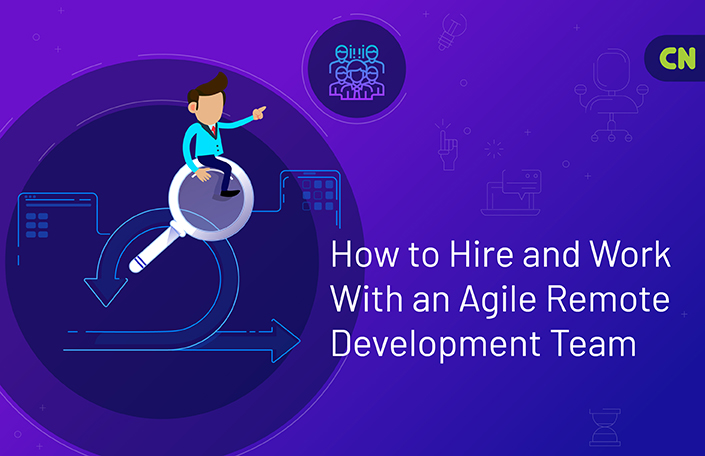How to Hire and Work With an Agile Remote Development Team
Table of Contents
It’s no secret that we love agile frameworks and methods at Capital Numbers. That’s because agile presents such a convenient and efficient way to approach software development — not only for the developers, but for our clients.
As software development grows more advanced and more complicated, small teams with a lot of moving parts must find a way to work together and deliver high-quality development at high speed. This is made even more complicated when you work with an offshore client or team — which is why using an agile approach is so important.
Most people understand that agile is great with an in-house team… but did you know it can be even better when hiring offshore? In fact, combining agile with offshore development is becoming increasingly necessary. Agile is great for managing the challenges that come from working with various team members, some from different cultures, most in different time zones… and maintaining quality and efficiency across every part of the team.
There are 3 main steps you can expect your agile remote development team to go through, and several more you can expect from a top-tier remote software developer. If you would like to know what they are, keep reading…
Step 1: Deep Dive, Vision Statement, and Consultation
The key thing to keep in mind, as with starting any project, is the importance of clear communication and understanding across all parties. This step is vitally important for making your needs understood… and because it will set the stage for the rest of the project.
If you don’t nail this step, you’ll run into problems that could be avoided and challenges that slow the whole project down.
Here’s how to get it right:
First, determine the scope of work. You’ll need to determine how much work, with a hard deadline, must be completed by a given date. You’ll be thinking about milestones… touchpoints… deliverables… and everything else needed to present a clear and total vision of the project to the team.
If this is your first time, your remote development partner should help guide you through this step. At Capital Numbers, we have walked many clients through this process. It is usually more in-depth than they expect, and that’s for good reason. If we get this right, the rest of the project will often go smoothly.
After the initial “vision statement,” we will then divide the project into specific tasks for the team. In agile, flexibility is a key concern. So, when we divide up these tasks, we will then be able to change their priority, their deadlines, which team handles them. Later, we’ll use these tasks to plan product iteration.
Speaking of flexibility…
Step 2: Flexible, process-oriented product roadmap
So you have the task list, vision statements, and scope of work completed. Now it’s time to divide everything up into time intervals. These are the estimated amounts of time it will take the team to complete each task.
Put together, these intervals create a “roadmap” for product development. This product roadmap will be your guide throughout the entire process. It will define clear requirements for the team — including deadlines — and it will define parameters which allow you the flexibility to take advantage of the agile framework.
The beauty of agile development is that it allows for variation in deadlines, speed, and functionality. If you have a clear “definition of done,” the details of each requirement may change as your priorities shift, while still continuing to serve your definition of done.
Even if these factors do change, you will still have your product roadmap to refer to — it will give all team members clarity in the high-level process of development. Sometimes you’ll need to make changes in the direction you’re going (as priorities shift). Keep in mind that this is why we divide the process into the quick iterations mentioned above — these are called sprints — and are fulfilled within a given timeframe.
Step 3: Regular, Repeated Demonstrations To Maintain Collaboration
As the client, you should request regular demonstrations at the end of each iteration. Good development partners will offer these anyway, and you’ll agree on them beforehand. These demonstrations will give you an idea of what the team has achieved and you can see the product taking shape before it’s done.
You’ll also be able to check off the requirements if the team has performed according to your expectations — and if not, you’ll have the opportunity to clarify your needs. The project manager will also document any feedback or corrections going forward.
This will ensure a continuous, sustained level of collaboration between the team, the managers, and the client.
What To Expect From a Good Agency
While the previous three steps are absolutely necessary to even begin work on an agile project, the following steps will be included by very good remote agencies.
Seek out remote development partners that offer the following:
Consistent Development Environment
At Capital Numbers, we made a conscious decision to maintain an ideal environment for developers. Our offices all have state of the art infrastructure and developers sit in an open, airy space that encourages collaboration and creativity. Furthermore, we have robust project management systems in place so that the way we approach development is consistent across all teams and individuals. Expect the same from your remote partner.
Asynchronous Timing
Trying to sync up multiple different teams and individuals in multiple different time zones is an exercise in futility. Instead, time communications to accommodate one another. This will work in your favor, as you can give directions to your team on your schedule and they can do the work as you sleep, and vice versa.
Project Management Tools
If you don’t have access to robust project management tools, no worries. Your team should provide them. We like Teamwork for ongoing project updates and communication, but there are plenty of others. Plus, a good team will be able to adapt to your way of doing things as well.
Conclusion
As agile grows in popularity, it is increasingly likely your remote team will be using it for your projects. Keep the best practices of agile development in mind even when hiring remotely — they will work in your favor. For best results, be sure to seek out a good remote development partner with a lot of experience in agile.















